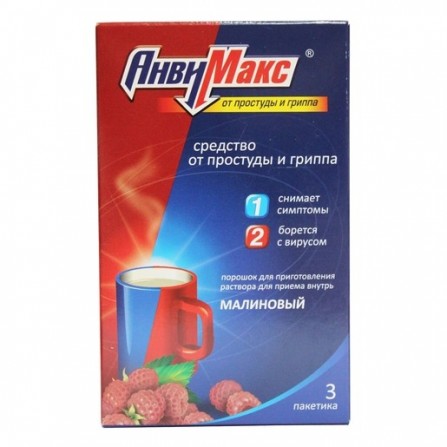AnviMax powder for preparation of solution of raspberry 5 g 3 pieces
Condition: New product
1000 Items
Rating:
Be the first to write a review!

More info
Active ingredients
Paracetamol + Rimantadine + Ascorbic Acid + Loratadine + Rutoside + Calcium Carbonate
Composition
In 1 package: paracetamol 360 mg. ascorbic acid 300 mg. calcium gluconate monohydrate 100 mg. Rimantadine hydrochloride 50 mg. Rutoside (in the form of trihydrate) 20 mg. loratadine 3 mg. Excipients: aspartame - 30 mg, hypromellose - 10 mg, colloidal silicon dioxide - 20 mg, lactose monohydrate - 4086 mg, flavoring (raspberry) - 21 mg.
Pharmacological effect
The combined drug has antiviral, interferonogenic, antipyretic, analgesic, antihistamine and angioprotective effects. Paracetamol has an analgesic and antipyretic effect. Ascorbic acid is involved in the regulation of redox processes, contributes to the normal permeability of capillaries, blood clotting, tissue regeneration, plays a positive role in the development of immune reactions of the body, compensates for vitamin C deficiency, prevents the development of increased permeability and fragility of blood vessels , causing hemorrhagic processes in influenza and acute respiratory viral infections, has antiallergic effect (mechanism is unclear). Rimantadine has antiviral activity against the influenza A virus. Blocking the M2 channels of the influenza A virus, impairs its ability to penetrate cells and release ribonucleoprotein, thereby inhibiting the most important stage of viral replication. Induces the production of interferon alpha and gamma. With influenza B virus, rimantadine has an antitoxic effect. Rutoside is an angioprotector. Reduces capillary permeability, swelling and inflammation, strengthens the vascular wall. It inhibits aggregation and increases the degree of red blood cell deformation. Loratadine, a blocker of histamine H1 receptors, prevents the development of tissue edema associated with the release of histamine.
Indications
Etiotropic treatment of type A flu. symptomatic treatment of colds, influenza and ARVI, accompanied by fever, muscle pain, headache, chills in adults.
Contraindications
Hypersensitivity to one or more components,part of the drug. erosive and ulcerative lesions of the gastrointestinal tract in the acute phase. - gastrointestinal bleeding. hemophilia. hemorrhagic diathesis. hypoprothrombinemia. portal hypertension. vitamin deficiency. renal failure. thyroid disease. acute kidney disease, liver (acute glomerulonephritis, acute pyelonephritis, acute hepatitis), or exacerbation of chronic diseases of these organs. chronic alcoholism. hypercalcemia, severe hypercalciuria. nephrourolithiasis. sarcoidosis. simultaneous reception of cardiac glycosides (risk of arrhythmias). lactose intolerance, lactase deficiency, glucose-galactose malabsorption. phenylketonuria (for powder). pregnancy breastfeeding period. children and adolescents up to 18 years.
Use during pregnancy and lactation
Use during pregnancy and during breastfeeding is contraindicated.
Dosage and administration
The drug is taken orally after a meal. Capsules should be washed down with water. The powder (contents of 1 sachet) must be dissolved in 1/2 cup of warm boiled water and stirred. The resulting solution should be consumed immediately after preparation. Adults are prescribed 1 capsule P blue and 1 capsule P red (single dose) or 1 sachet of powder 2-3 times / day. The drug should be taken within 3-5 days (no more than 5 days) until the symptoms of the disease disappear.
Side effects
On the part of the nervous system: irritability, drowsiness, tremor, hyperkinesia, dizziness, headache, flushing of the blood to the face. On the part of the digestive system: damage to the mucous membrane of the stomach and duodenum, dyspepsia, dry mucous membrane in the mouth, lack of appetite, flatulence, diarrhea. On the part of the urinary system: moderate pollakiuria. From the hemopoietic system: changes in blood parameters (control is needed). On the part of the endocrine system: inhibition of the function of the insular apparatus of the pancreas (hyperglycemia, glycosuria). Allergic reactions: skin rash, itching, urticaria. If any of the side effects indicated in the instructions are aggravated or any other side effects that are not indicated in the instructions are noted, the patient should immediately inform the doctor.
special instructions
On the part of the nervous system: irritability, drowsiness, tremor, hyperkinesia, dizziness, headache, flushing of the blood to the face. On the part of the digestive system: damage to the mucous membrane of the stomach and duodenum, dyspepsia, dry mucous membrane in the mouth, lack of appetite, flatulence, diarrhea. On the part of the urinary system: moderate pollakiuria. From the hemopoietic system: changes in blood parameters (control is needed). On the part of the endocrine system: inhibition of the function of the insular apparatus of the pancreas (hyperglycemia, glycosuria). Allergic reactions: skin rash, itching, urticaria. If any of the side effects indicated in the instructions are aggravated or any other side effects that are not indicated in the instructions are noted, the patient should immediately inform the doctor.





